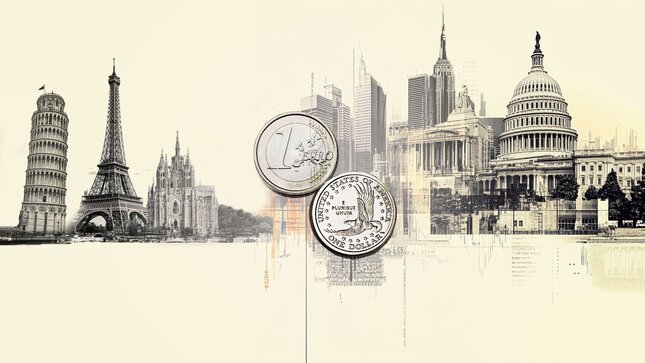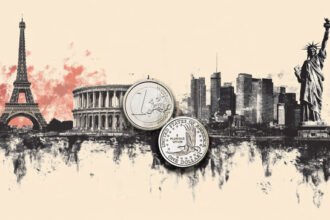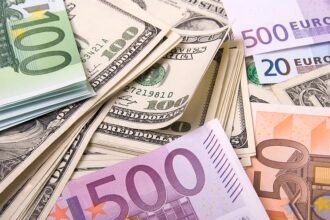EUR/USD moves sideways below 1.1600 in the European session on Wednesday, after closing in positive territory on Tuesday. Investors await comments from Federal Reserve (Fed) officials.
Euro Price This week
The table below shows the percentage change of Euro (EUR) against listed major currencies this week. Euro was the strongest against the Japanese Yen.
| USD | EUR | GBP | JPY | CAD | AUD | NZD | CHF | |
|---|---|---|---|---|---|---|---|---|
| USD | -0.22% | -0.01% | 0.50% | -0.35% | -0.76% | -0.58% | -0.80% | |
| EUR | 0.22% | 0.19% | 0.77% | -0.16% | -0.57% | -0.40% | -0.61% | |
| GBP | 0.00% | -0.19% | 0.65% | -0.35% | -0.76% | -0.58% | -0.80% | |
| JPY | -0.50% | -0.77% | -0.65% | -0.92% | -1.31% | -1.14% | -1.40% | |
| CAD | 0.35% | 0.16% | 0.35% | 0.92% | -0.32% | -0.24% | -0.51% | |
| AUD | 0.76% | 0.57% | 0.76% | 1.31% | 0.32% | 0.17% | -0.05% | |
| NZD | 0.58% | 0.40% | 0.58% | 1.14% | 0.24% | -0.17% | -0.22% | |
| CHF | 0.80% | 0.61% | 0.80% | 1.40% | 0.51% | 0.05% | 0.22% |
The heat map shows percentage changes of major currencies against each other. The base currency is picked from the left column, while the quote currency is picked from the top row. For example, if you pick the Euro from the left column and move along the horizontal line to the US Dollar, the percentage change displayed in the box will represent EUR (base)/USD (quote).
On Tuesday, the weekly data published by the Automatic Data Processing (ADP) showed that private employers shed an average of 11,250 jobs a week, for the four weeks ending October 25. This report revived concerns over the labor market conditions and weighed on the US Dollar (USD). In turn, EUR/USD climbed above 1.1600 for the first time in November.
The economic calendar will not offer any high-impact data releases on Wednesday. In the meantime, US stock index futures were last seen rising between 0.2% and 0.6% on the day. In case risk flows dominate the markets in the second half of the day, EUR/USD could continue to stretch higher.
Market participants will also scrutinize Fed commentary. According to the CME FedWatch Tool, markets are currently pricing in about a 63% probability of a 25 basis points rate cut in December.
In case policymakers acknowledge worsening conditions in the labor market, the USD could have a difficult time finding demand. Conversely, the USD could stay resilient against its peers if Fed officials cling to a cautious tone on further policy easing, citing the uncertainty surrounding the inflation outlook.
EUR/USD Technical Analysis:
In the 4-hour chart, EUR/USD trades virtually unchanged on the day at 1.1583. The 20-period Simple Moving Average (SMA) climbs above the 50-period one, while price holds above both and has edged back over the 100-period SMA. The 100- and 200-period SMAs slope lower, with the latter still overhead and capping the upside. The Relative Strength Index (14) stands at 59, signaling firm momentum without overbought pressure. Measured from the 1.1885 high to 1.1472 low, the Fibonacci 23.6% retracement at 1.1569 offers immediate support.
Near term, initial resistance aligns at the 38.2% retracement at 1.1630. A break higher would expose the next Fibonacci barrier (50%) at 1.1680. On the downside, support is seen at 1.1551. The setup leans mildly bullish while price remains above the 20- and 100-period SMAs, but a failure to hold 1.1551 would undermine the tone and refocus the pullback.
(The technical analysis of this story was written with the help of an AI tool)
Euro FAQs
The Euro is the currency for the 20 European Union countries that belong to the Eurozone. It is the second most heavily traded currency in the world behind the US Dollar. In 2022, it accounted for 31% of all foreign exchange transactions, with an average daily turnover of over $2.2 trillion a day.
EUR/USD is the most heavily traded currency pair in the world, accounting for an estimated 30% off all transactions, followed by EUR/JPY (4%), EUR/GBP (3%) and EUR/AUD (2%).
The European Central Bank (ECB) in Frankfurt, Germany, is the reserve bank for the Eurozone. The ECB sets interest rates and manages monetary policy.
The ECB’s primary mandate is to maintain price stability, which means either controlling inflation or stimulating growth. Its primary tool is the raising or lowering of interest rates. Relatively high interest rates – or the expectation of higher rates – will usually benefit the Euro and vice versa.
The ECB Governing Council makes monetary policy decisions at meetings held eight times a year. Decisions are made by heads of the Eurozone national banks and six permanent members, including the President of the ECB, Christine Lagarde.
Eurozone inflation data, measured by the Harmonized Index of Consumer Prices (HICP), is an important econometric for the Euro. If inflation rises more than expected, especially if above the ECB’s 2% target, it obliges the ECB to raise interest rates to bring it back under control.
Relatively high interest rates compared to its counterparts will usually benefit the Euro, as it makes the region more attractive as a place for global investors to park their money.
Data releases gauge the health of the economy and can impact on the Euro. Indicators such as GDP, Manufacturing and Services PMIs, employment, and consumer sentiment surveys can all influence the direction of the single currency.
A strong economy is good for the Euro. Not only does it attract more foreign investment but it may encourage the ECB to put up interest rates, which will directly strengthen the Euro. Otherwise, if economic data is weak, the Euro is likely to fall.
Economic data for the four largest economies in the euro area (Germany, France, Italy and Spain) are especially significant, as they account for 75% of the Eurozone’s economy.
Another significant data release for the Euro is the Trade Balance. This indicator measures the difference between what a country earns from its exports and what it spends on imports over a given period.
If a country produces highly sought after exports then its currency will gain in value purely from the extra demand created from foreign buyers seeking to purchase these goods. Therefore, a positive net Trade Balance strengthens a currency and vice versa for a negative balance.





















